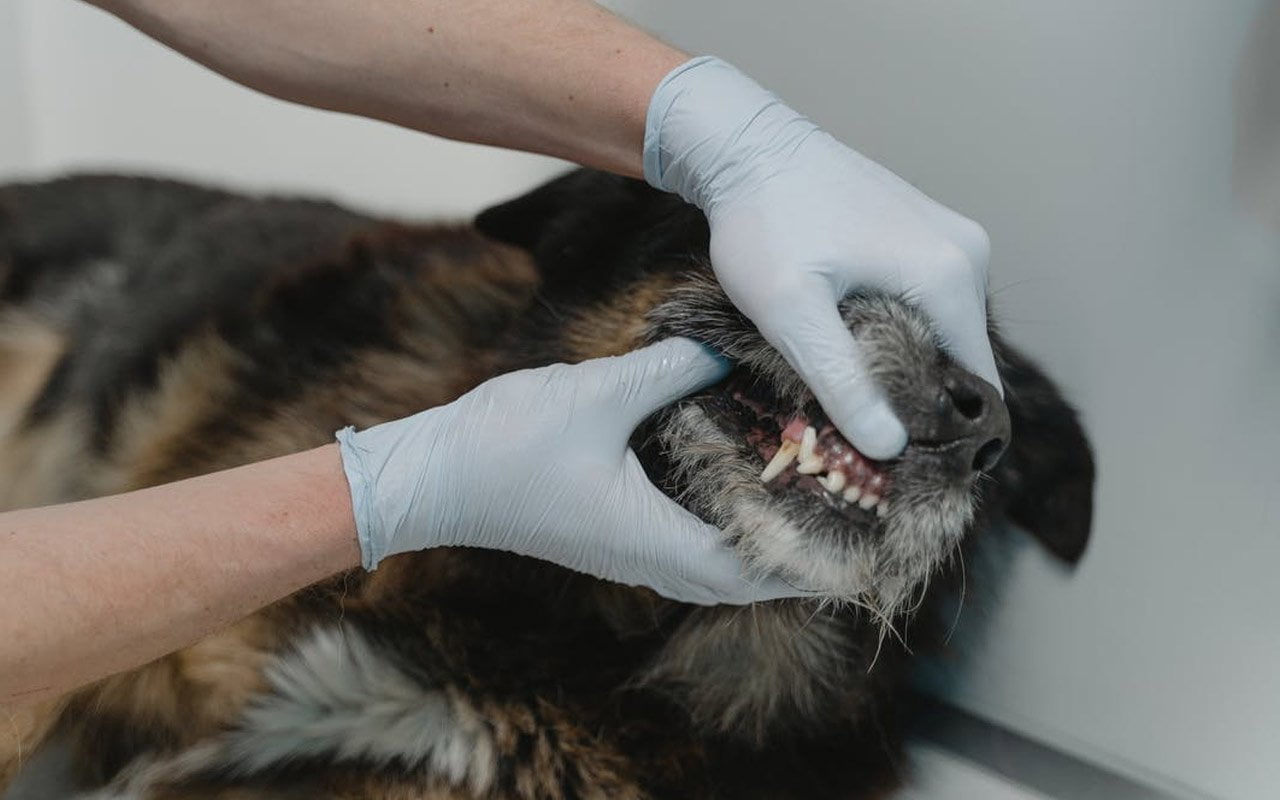Fever in dogs is a normal reaction to an illness or infection. The body raises the temperature of the body to try and deal with the issue. In itself, it is not dangerous and generally, a dog can deal with a fever very well, however, if the fever becomes too high it can be a sign of something more serious.
If you are concerned about your dog having a fever, there are ways to determine what is causing it. The first way to find out if your dog has a fever is to feel the dog’s side with your hand. The second way is to run your hand across your dog’s tongue. Feel for a small bump in the middle of the tongue, which is called the vallate papillae.
It is a common experience to see your dog sniffing, licking, and scratching itself. It can also be common to see your dog with its tail between its legs and hiding in the corner of the room. When this happens, you may start to worry that they may have contracted something like worms or fleas, or even rabies. Is it possible that your dog has a fever?
Do you know what is the normal temperature for a dog and what is the temperature of a fever?
A dog’s normal body temperature ranges from 101° to 102.5°F, which is significantly higher for a human with a body temperature of 97.6° to 99.6°F. A temperature of more than 103°F is considered a dog with a fever. When temperatures reach 106°F, serious complications and death can occur.
Detecting fever in dogs can be difficult. This article will explain how to detect fever in dogs, the causes, symptoms and what you need to know to care for your pet. Here are some things you need to know about fever in dogs.
Table of Contents
What causes fever in dogs?
A high body temperature is called fever. Dogs and cats can also suffer from infections of the brain, urinary tract, lungs, skin, bones, and joints. Fever is a very frequent symptom in the case of these infectious diseases. Fever is a means for the body to fight infection.
Dogs get fevers for the same reasons we do — it’s a natural response to bacteria, viruses, or other potentially harmful substances in their systems. It’s important to remember that while dogs can get fevers just like we can, they don’t experience the same types of fevers we do. A fever in humans is usually related to an infection, but in dogs, it can be caused by a variety of factors including exposure to toxins, poor diet, and heart disease.
Fevers may be uncomfortable for us humans, but they can be deadly for dogs. A dog’s normal body temperature is 101°F to 102°F. If it goes higher than 103.5°F, your pet could have a fever. If the fever is accompanied by other symptoms, such as lethargy or panting, your dog may have an infection.
Fever is a symptom of an underlying condition. The most common causes of fever in dogs are infectious diseases, as well as cancer and tumors. Any disease that leads to inflammation can be accompanied by fever. Canine distemper virus, parvovirus, Lyme disease, and parasites like heartworms and hookworms are all examples of infectious diseases that can cause fever.
Fever in dogs can be a sign of many different underlying health problems, from a common cold or upper respiratory infection to something more serious, like cancer.
Fever in dogs is not an illness itself, but rather a sign that something is wrong. Dogs can have a fever because of an infection caused by bacteria, viruses, or parasites, or because of an injury or trauma.
Dog fever can be caused by a variety of conditions and illnesses. These conditions include:
- An infection that is either bacterial, fungal, or viral
- A bacterial infection of the ear
- An infected bite or scratch
- Tooth infection or abscess
- Infections of the urinary tract
- Consumption of poisonous substances, such as toxic plants, toxic medications, toxic human foods, or other toxins can result in seizures or death.

Sometimes, the cause of a dog’s fever is not easily identifiable. This is known as a fever with an unknown origin (FUO). These cases could indicate underlying diseases of the immune system, bone and marrow problems, cancer, or other conditions.
Did you know:
One of the most common ailments among dogs after whelping is known as milk fever also called canine eclampsia or lactational hypocalcemia. Milk fever in dogs is a condition that can occur when the mother gives birth.
This usually happens when the mother transfers her calcium to her puppies through her milk. The condition can turn fatal within 30 minutes and treatment must be sought within that time.
Symptoms

From hyperthermia to dehydration, to heatstroke and even shock, here are the main symptoms that your dog could be suffering from a fever.
Overheating, panting, excessive salivation and restlessness are the most common symptoms of a fever in dogs. A high temperature will only be temporary and it’s important to understand what’s causing it and how to treat your dog for it.
If a dog starts showing signs of lethargy, loss of appetite, or excessive thirst, it’s time to worry. Even if your dog exhibits just a couple of these symptoms, you should take him to your vet because this could be a sign of fever in dogs. Any dog can come down with some sort of fever, however, it does tend to be more common in puppies and older dogs.
It is important to know the signs of a fever in dogs, particularly if you are not sure if you have taken your dog to the vet you can potentially save your dog’s life.
You can tell if your dog is feeling sick by a change in his behavior. Your dog will feel the same as you do when you have a fever.
If a dog became mopey, which was my first sign that your dog wasn’t feeling well. He preferred to chillax, but if he refuses to walk with you or run when we move to the kitchen, it is a sign that something is wrong.
The next signs are glassy eyes and warmth to the touch. Also look out for signs such as shivering and panting, runny eyes, nausea, decreased energy, depression, or loss of appetite. You should take a thermometer if your dog experiences any combination of these symptoms.
You should immediately notice any significant changes in your dog’s behavior. Keep an eye on your dog, and note any changes in behavior. You should take note of any combination of these symptoms to determine if your dog is at risk.
If you have noticed one or more of these symptoms it is best to take your pet to the vet and get treated. These are most frequent symptoms of a dog’s fever are:
- Coughing
- Decreased energy
- Loss of appetite
- Red or glassy-looking eyes
- Runny nose
- Shivering
- Panting
- Vomiting
- Warm ears and/or nose
Recognizing Fever in Dogs
Dogs can get a wide range of illnesses, just like people. The key to recognizing fever in dogs is to learn more about it, so you can know when to seek professional medical care.
But, when can dogs have a fever? Fever is considered normal for the body’s immune systems to fight certain infections, but it can also be a symptom of a serious, potentially deadly disease.
An important part of keeping your dog healthy is to recognize the symptoms of illness or injury. Sometimes it’s obvious, but other times your dog may not exhibit symptoms until it’s too late to help.
Fever in dogs is something that you’ll need to be able to identify right away, so you can begin administering treatment quickly. Dogs can have fever for several reasons, some of which are harmless and others that are very serious. If you notice your dog has a fever, it’s important to contact your veterinarian immediately.
Here’s what you need to know about fever in dogs so that you can spot it and take steps to help your pup get better.
It’s never good to see your dog sick. Your furry friend may seem to be less energetic than usual, scratching itself or licking a certain body part more than usual. If you notice any of these signs, you can consider that your dog may be having a fever.
Just like people, dogs’ normal body temperatures vary a bit. A dog’s normal temperature can range anywhere between 100.4 and 102.5. To figure out what’s “normal” for your dog, you’ll need to take his temperature with a thermometer when he’s feeling well. You can also make a note of it during routine vet visits when your pup isn’t sick.
Keep in mind that temperatures can vary a bit throughout the day. Dog’s temperature could naturally go up a bit at night. So understanding your dog’s “healthy temperature” could mean tracking his readings at various times of the day for a few days.
If your dog suffers from a fever, then they need to see the vet. It’s better to take their temperature at home than wait until it’s too late. You should never leave your dog with a critical fever for too long if you can help it. In the meantime, here’s how you can take their temperature.
Dogs are susceptible to the same pathogens and diseases as humans. While the symptoms of the diseases can seem similar, the way in which they are manifested in dogs can be different. It is important to recognize these differences so you can effectively treat your pet.
When a pet has a high fever, it can be difficult to know whether it’s best to call the veterinarian or run out to the local pharmacy. In addition, some people may worry about the cost of a visit to the veterinarian or that the vet bill will be too high.
It’s important to remember that some conditions require immediate attention, while others can be monitored over time. So, how to Tell If Your Dog Has A Fever? You can rely on the signs listed in the Symptoms section above to recognize signs of fever in dogs and how to support treatment.
Unlike people, dogs can’t tell you when they’re not feeling well. But you know when something’s not right. Determining if your dog has a fever can help you get to the bottom of what’s causing your pet’s discomfort.
The most important step in figuring out whether your dog has a fever is knowing his normal temperature.
Knowing your dog’s healthy pulse, respiratory rate, and capillary refill time are also handy tools in assessing a potential illness.
Fever and monitoring temperature are two important things to keep your pet healthy, especially if your pet is a dog. Dogs are naturally outdoor animals, so they can easily get sick with infectious diseases or bite other dogs. As most of you know, fever and monitoring temperature will help you to diagnose health problems in dogs. The table below will give you some useful information for monitoring a dog’s fever temperature.
| Temperature | Color Code | Fever | Action |
|---|---|---|---|
38.3 – 39.2 degC (100.5 – 102.5 degF) | No fever Normal temperature range | None | |
>39.5 degC (103 degF) | Mild-Moderate fever | It is recommended to call a veterinarian. Be sure to keep an eye on your dog. It is possible to provide home care. | |
>40 degC Recommended read: (>104 degF) | Moderate-Serious fever | Consult your veterinarian Expert assessment and treatment are possible. | |
>40.5 degC (>105 degF) | Serious-Emergency fever | Call veterinarian; Only professionals can provide professional assessment and treatment. | |
>41 degC (>106 degF) | Emergency and life-threatening fever | Prompt professional assessment and treatment are required. |
What To Do When Your Dog Has A Fever
https://www.youtube.com/watch?v=Jaa_zIXoYVo
A recent survey found that 43% of dog owners have reported that their dogs experience a fever at one time or another. Dog owners can find themselves in a difficult and confusing position, especially when their dog is experiencing high fevers.
Fever is a common sign in both animals and humans. It is not always a sign that there is an infection. Fever can occur when there is inflammation in the body or as a reaction to infection.
Fever can also be a sign of other health issues such as cancer and autoimmune diseases. It is crucial to monitor your pet’s temperature regularly and to contact your veterinarian if your pet’s temperature rises.
Fever is a temporary rise in body temperature. This is an indication that your dog’s immune systems are fighting infection. The temperature can be brought down by using a cooling agent like cold water, ice, or even a fan. Some dogs may also find relief from pain by using alcohol or hydrogen peroxide to clean the affected area.
Your dog’s body temperature can rise, just like humans. This is to fight infection and inflammation. A fever can be caused by an infection such as a virus, infected cuts, or a urinary tract infection. How can you tell when to get serious?
Every fever should be reported to the vet. It is a good idea for your dog to inform your vet about any health issues. A temperature below 103 can usually be monitored at home for 24 hours. A fever higher than 103 or that lasts more than 24 hours requires a visit to the veterinarian.
Temperatures of 106°F or more can cause serious damage to the dog’s internal organs. This could lead to death. This is a serious condition and should be closely monitored.
Your vet should be consulted before you take any action to lower your dog’s fever. Aspirin may prevent you from using other medications that can lower your dog’s temperature.
If your pet has a fever that is severe enough to warrant a vet visit you can expect him to be given IV fluids and anti-inflammatory medication. To determine the source of your pet’s fever, your vet may recommend blood tests.
It can be hard to pinpoint the cause of fever because there are so many possible causes. Keep your dog hydrated and comfortable to help him fight off any bug.
If your dog has a fever of 106 degrees F or more, immediately bring him to a local emergency clinic.
Cool water can be applied to the ears and paws of your dog if they are suffering from a fever. If your dog’s temperature falls below 103degF, stop applying water.
You can encourage your dog to drink water, but not force him to.
You should never give your dog any human medication, such as acetaminophen and ibuprofen. These medications can cause serious injury or even death for your dog.
You should take your dog to the veterinarian if your dog displays any other symptoms such as vomiting, panting, or shivering.
This post contains informational content only and is not intended to be a diagnosis or treatment for pets or people. Follow your doctor’s advice about asthma and other allergies.
Home remedies for fever in dogs
You should immediately address a dog’s fever. The normal body temperature for a dog is between 100 and 102.5 degrees Fahrenheit. An elevated temperature can signify illness or injury so it is important to act quickly to bring it down. These natural remedies can help your dog fight his fever.
Cool water can be applied to the ears and paws of a pet that has a fever above 103 degrees. A soaked towel, cloth, or dog cooling vest can be used. Keep an eye on his temperature and stop using the water if it falls below 103. Try to get him to drink a little water.
Keep an eye on his temperature and stop giving him water if it falls below 103. In the event that the fever becomes contagious, keep him away from any pets.
These are the steps to follow:
- Use fever reducer for dogs
- Hydrate your dog
- Chicken soup for dogs
To reduce your dog’s fever, you might also consider giving him a homeopathic remedy.
These are some of the most effective treatments that you can use. Before you begin any treatment, it is best to consult a holistic vet first. Many holistic vets offer phone consultations.
Homeopathic remedies for dogs can be used in place of other medications. However, they have side effects. If the dog is not being treated with other options, homeopathy can be used. Homeopathy can be used for many ailments. These remedies are most often used by canines.
Arsenicum Album
Arsenicum album, a homeopathic remedy for dogs, is also very popular. It can be used to treat digestive problems or toxicities and it can also work well as a liver cleanser.
Arsenicum dilutions can be beneficial for dogs suffering from chronic vomiting or diarrhea.
Rus Toxicodendron
Rus Toxicodendron, a homeopathic remedy for joint pain in older dogs, can be used. The ingredient can also be used to diluent dogs with:
- Itchy skin
- Dermatitis
- Lengthening of the limbs
- Injury to the muscle or sprain
- Conjunctivitis
Silica
Silica can be used to diluent chronic canine conditions that need a long treatment.
Silica works in:
- Reduce abscesses, cysts
- Ulcers
- Problems with the anal glands
- Irritation and swelling at the injection site
Arnica Montana
Arnica Montana can be toxic but is used to make homeopathic remedies for dogs. It is useful in:
- Reduce pain due to different diseases
- Reduce injuries and bruising
- Energy deficiency
Apis Mellifica
Apis Mellifica, a homeopathic remedy that uses the venom of bees, may cause a reaction similar to a bee sting. Major irritation is similar to a bee bite, but dogs should experience gradual improvement.
This remedy can be used for dogs with:
- Tick bites, and other insect bites
- Allergy to foods, vaccines, or other inhalants
- Hot spots
- Red eyes
- Itchy skin
Pets with severe allergies to bee venom should not use the Apis homeopathic remedy anaphylaxis.
Hepar Sulphuris
Hepar Sulphuris, an anti-inflammatory ingredient, is used in homeopathic remedies.
Dogs with:
- Skin infections
- Infections such as those in the urinary tract can cause internal infections.
- Dental abscesses
- Pain
- Lethargy
Aconitum Napellus
Aconitum Napellus also known as Aconite, is a homeopathic remedy that dogs can use to treat the following conditions:
- Anxiety and stress
- Fear (i.e. Fear (i.e., thunder or fireworks)
- Elevated fever
- Pain can come from many illnesses.
- Reduce shock
- Symptoms of a severe respiratory infection
Nux Vomica
Homeopathy uses Nux Vomica to treat allergic reactions or buildups of toxins.
The nux vomica also has other effects:
- Itching can be reduced
- Eliminate vomiting, diarrhea
- Respiratory infections can be treated
Phosphorus
Phosphorus, a substance found in dogs’ diets, can be used in homeopathic remedies to treat conditions like:
- There is blood in the stool and vomit
- Coagulation disorders
- Reduce bleeding
- Respiratory infections
- Nausea
To help boost the immune system, vitamins and herbs can be administered to dogs who experience fever.
- Vitamin C: Vitamin C is an effective antioxidant that can help build immunity. Your dog should be given 5-10mg/lb 2-3 times per day.
- Vitamin E: Vitamin E can be given to your dog (5-10mg/lb once daily) to increase his immunity.
- Echinacea: Echinacea can boost the immune system. A natural product like Animal Essentials Super Immune support (affiliate Link) is a great way to boost your immune system.
It is rich in Siberian Ginseng, echinacea, and olive leaf. This herb has been shown to be effective in boosting immunity and fighting off low-grade infection.
How to comfort a dog with a fever
The best way to comfort a dog with a fever is to give him a quiet, cool place to rest. Provide fresh, cool water. You can put cool compresses in his groin or on his paws for cooling. Alcohol wipes can also be used on the paws but sparingly.
One of the most important things to remember when treating a dog with fever at home is never give paracetamol that’s made for humans. Be careful to not soak it. If you try to lower the fever with an excessively humid rag you can make his situation worse by making him catch a cold and making the fever higher.
How do I take Dog’s Temperature?
Get a good digital thermometer meant for rectal use, and mark it “Dog Thermometer.” Keep it anywhere except in your human medicine cabinet. You don’t want a sick family member accidentally using it in a feverish haze!
Denise Fleck, pet safety guru, provides the following advice on taking your dog’s temperature:
After lubricating the tip of a digital thermometer with petroleum or water-soluble jelly, lift your dog’s tail up and to the side to prevent him from sitting. Then carefully insert the thermometer ½” to 1” into the rectum. Wait for the thermometer to beep, indicating that it’s registered your dog’s temperature.
If your pup’s temperature is higher than normal, it might be time to call your veterinarian.
The best way to check your dog’s temperature is to use a digital thermometer for rectal use, some pet stores carry thermometers made just for pets. It is recommended that you keep a separate thermometer just for your dog and store it where you keep your dog’s supplies.
Start by lubricating the tip of the thermometer with petroleum or water-soluble lubricant. Then lift your dog’s tail up and to the side and carefully insert the thermometer about 1 inch into your dog’s rectum. If possible, have a second person assist you by holding under the dog’s hind legs to prevent your dog from sitting. Once the thermometer temperature has registered you can carefully remove the thermometer.
valley fever in dogs 8,100 $2.16 47
symptoms of valley fever in dogs 2,900 $1.62 45
fever in dogs symptoms 2,900 $2.47 55
valley fever in dogs symptoms 1,900 $0.49 6
natural remedies for valley fever in dogs
valley fever in dogs survival rate
rocky spotted mountain fever in dogs 1,900 $0 6
symptoms for valley fever in dogs 1,900 $1.52 6
rocky mountain spotted fever in dogs 1,900 $0 48
symptoms of fever in dogs 1,300 $0.07 6
fever in dogs signs
rocky mountain spotted fever in dogs
milk fever in dogs
tick fever in dogs

